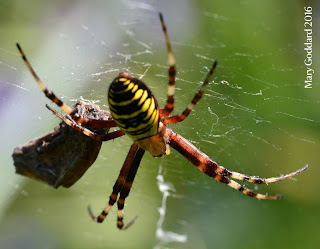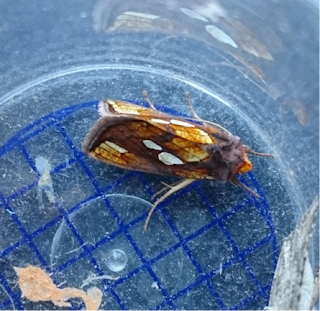Fresh Painted Lady (Mary Goddard)
At Gramborough Hill, Salthouse, a Wasp Spider was seen earlier in the month. First recorded in Britain in 1922, in southern England, the Wasp Spider has seen a substantial increase since 1990, spinning its orb web preferentially in coastal chalk and rough grasslands. At Salthouse, it was seen preying on Gatekeeper butterflies.
Wasp Spider at Salthouse (Mary Goddard)
On Blakeney Point this evening, a hatch of flying ants drew in every Black-headed Gull in the area to come and feed. This short video from exactly a year ago shows gulls flocking to the dunes during a 'hatch'...
"Aerial picnic" (Ajay Tegala)
The Grey Hair-grass on the Point has now turned straw-coloured. This nationally scarce grass is native only to Norfolk, Suffolk and the Channel Islands. It is abundant on Blakeney Point and is one of the features that earns the Point special conservation designations.
Grey Hair-grass blowing in the breeze (Ajay Tegala)
The week has not been without its migrant birds. Willow Warblers peaked at 19 on Monday 22nd, on the same day six Spotted Flycatchers were recorded. Wednesday 24th produced six Wheatears, a Short-eared Owl and a Black Redstart that has stayed near the Lifeboat House ever since. Other migrants this week included Pied Flycatchers, Whinchats and this afternoon an Ortolan Bunting was reported near the boardwalk.
Black Redstart on solar panel (Tom Whiley)
Finally, we would like to remind you that, although most of the Point is currently accessible at this time of year, there are three sanctuary areas to protect migrant birds and resting seals. Please help by not entering these fenced areas and keeping dogs under close control. We appreciate your cooperation in helping to protect this special wildlife haven.
Ajay,
Ranger


















